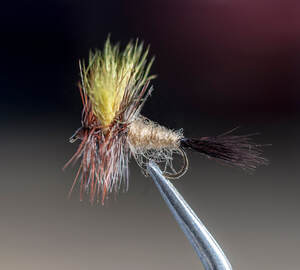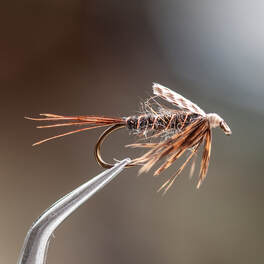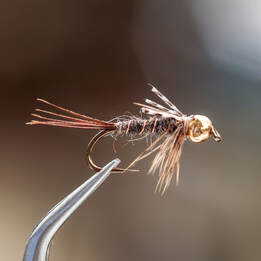Fly of the Month 01.22 - Murray’s Flies (Part I, see RRTU FOTM 0722 for Part II)
Harry Murray has been operating his drug store and his Virginia fly shop in the heart of the Shenandoah Valley since 1962. Murray’s Fly Shop is the home of the Mr. Rapidan series of fly patterns created by Harry Murray in 1971.
“Fueled by a passion for fly fishing, the great outdoors and a less than ideal availability of quality fly fishing gear, Harry Murray started Murray's Fly Shop in May 1962 in beautiful downtown Edinburg, Virginia. Since that time our enthusiasm for experiencing life with a fly rod in hand has grown across generations making countless friends along the way. Our Learn to Fly Fish beginner and advanced fly fishing schools, workshops and lessons are conducted throughout the year to help you better understand and enjoy fly-fishing. Take a minute to slow down, look around and take a deep breath. Tell us why you're here so we can help you meet your needs whether you need a new leader, directions to the best place to catch a trout on a dry fly or where to let your dog stretch his legs. You will find a full line of quality fly fishing equipment, gear and supplies from leading manufacturers such as: Scott, Winston, St. Croix, Orvis, Dan Bailey, Simms Fishing, Abel, Ross Reels, Metz, Renzetti, Scientific Anglers and many more. Our selection of fly fishing gear has been chosen carefully through years of trial and error. Simply put, we carry the gear we use. We feel strongly about the brands we stock. We are located at 121 South Main Street, Edinburg, VA 22824. Give us a call, 540-984-4212 or, better yet, stop by to say hi.” - Harry Murray
The Mr. Rapidan Series consists of fly patterns that attract trout, smallmouth bass and largemouth bass, particularity in the Shenandoah Valley and Shenandoah National Park. The Fly Fishing Museum of the Southern Appalachians recognizes the area as the northern most part of the geographical Southern Appalachians. Harry is best known for his published books on fly fishing for smallmouth bass, yet he is an avid mountain trout angler as well a diehard largemouth basser. His creative fly patterns are proof of his broad expertise in the pursuit of both trout and bass.
Mr. Rapidan Series
The most popular and best known of the series is the original Mr. Rapidan. Two students in his fly tying class requested a roughwater fly that best imitated the hatches in the local mountain streams. Harry experimented and finalized on his Mr. Rapidan. It became an instant success in the fly tying class. The fly pattern is a unique and creative derivative of a Wulff fly, using yellow calf tail for high visibility wings and a quill gordon Fly Rite dubbing body to best match the spring mountain hatches of the march brown and the quill gordon. Moose mane is used for the tail for high buoyancy and a mix of brown and grizzly hackle is used much like an Adams fly pattern.
Soon after, Harry added the Mr. Rapidan Emerger and the Mr. Rapidan Nymph to support the life-cycle of the spring hatch, thus, the Mr. Rapidan series was underway. For calmer waters and to get the body into the surface film, Harry added the Mr. Rapidan Parachute while fly fishing the Yellowstone River on a snowy September day.
The basic need for a more visible black ant led to the development of the Mr. Rapidan Ant. The abundance of Chironimid midge hatches in northern Virginia led to the development of the Mr. Rapidan Midge.
Both fly patterns utilize a highly visible topping of yellow hair strands.
The heavy, annual black caddis hatch led to the development of the Mr. Rapidan Delta Wing Caddis and the Mr. Rapidan Soft Hackle (a great imitation of a rising caddis pupa as well as a rising mayfly nymph). Harry’s first fly pattern was a black body and hair wing with, your guessed it, a topping of yellow hair strands. Black, olive and tan version of the Mr. Rapidan Delta Wing Caddis appear to meet all the needs on most Southern Appalachian trout streams.
The Hexagenia mayfly hatches on smallmouth rivers prompted the development of the Mr. Rapidan Bass Skater. For fly fishing on smallmouth waters, Harry claims the Mr. Rapidan Bass Skater is the “number one go-to fly” used on the fly shop’s guided trips.
The following is a list of the Mr. Rapidan series (with more likely being developed):
Mr. Rapidan
Mr. Rapidan Ant
Mr. Rapidan Bass Skater
Mr. Rapidan BH Nymph
Mr. Rapidan Delta Wing Caddis
Mr. Rapidan Emerger
Mr. Rapidan Midge
Mr. Rapidan Parachute
Mr. Rapidan Royal (tied by Bill Everhardt, Lenoir, NC)
Mr. Rapidan Soft Hackle
Mr. Rapidan Streamer
Practical options that have enhanced the Mr. Rapidan series include adding a bead to the original Mr. Rapidan Nymph and tying both trout and bass sized version of the various Mr. Rapidan fly patterns There is also a Mr. Rapidan Streamer that is highly effective for both trout and bass. For the fly of the month, we have focused on the mayfly life-cycle portion of the series that imitate the march brown Stenonemia vicarium and quill gordon Epeorus pleuralis mayflies and present the original Mr. Rapidan:
Murray’s Flies (Part I)
Mr. Rapidan
Mr. Rapidan Emerger
Mr. Rapidan BH Nymph
Fly of the Month 01.22
Tom Adams and Alen Baker
Harry Murray has been operating his drug store and his Virginia fly shop in the heart of the Shenandoah Valley since 1962. Murray’s Fly Shop is the home of the Mr. Rapidan series of fly patterns created by Harry Murray in 1971.
“Fueled by a passion for fly fishing, the great outdoors and a less than ideal availability of quality fly fishing gear, Harry Murray started Murray's Fly Shop in May 1962 in beautiful downtown Edinburg, Virginia. Since that time our enthusiasm for experiencing life with a fly rod in hand has grown across generations making countless friends along the way. Our Learn to Fly Fish beginner and advanced fly fishing schools, workshops and lessons are conducted throughout the year to help you better understand and enjoy fly-fishing. Take a minute to slow down, look around and take a deep breath. Tell us why you're here so we can help you meet your needs whether you need a new leader, directions to the best place to catch a trout on a dry fly or where to let your dog stretch his legs. You will find a full line of quality fly fishing equipment, gear and supplies from leading manufacturers such as: Scott, Winston, St. Croix, Orvis, Dan Bailey, Simms Fishing, Abel, Ross Reels, Metz, Renzetti, Scientific Anglers and many more. Our selection of fly fishing gear has been chosen carefully through years of trial and error. Simply put, we carry the gear we use. We feel strongly about the brands we stock. We are located at 121 South Main Street, Edinburg, VA 22824. Give us a call, 540-984-4212 or, better yet, stop by to say hi.” - Harry Murray
The Mr. Rapidan Series consists of fly patterns that attract trout, smallmouth bass and largemouth bass, particularity in the Shenandoah Valley and Shenandoah National Park. The Fly Fishing Museum of the Southern Appalachians recognizes the area as the northern most part of the geographical Southern Appalachians. Harry is best known for his published books on fly fishing for smallmouth bass, yet he is an avid mountain trout angler as well a diehard largemouth basser. His creative fly patterns are proof of his broad expertise in the pursuit of both trout and bass.
Mr. Rapidan Series
The most popular and best known of the series is the original Mr. Rapidan. Two students in his fly tying class requested a roughwater fly that best imitated the hatches in the local mountain streams. Harry experimented and finalized on his Mr. Rapidan. It became an instant success in the fly tying class. The fly pattern is a unique and creative derivative of a Wulff fly, using yellow calf tail for high visibility wings and a quill gordon Fly Rite dubbing body to best match the spring mountain hatches of the march brown and the quill gordon. Moose mane is used for the tail for high buoyancy and a mix of brown and grizzly hackle is used much like an Adams fly pattern.
Soon after, Harry added the Mr. Rapidan Emerger and the Mr. Rapidan Nymph to support the life-cycle of the spring hatch, thus, the Mr. Rapidan series was underway. For calmer waters and to get the body into the surface film, Harry added the Mr. Rapidan Parachute while fly fishing the Yellowstone River on a snowy September day.
The basic need for a more visible black ant led to the development of the Mr. Rapidan Ant. The abundance of Chironimid midge hatches in northern Virginia led to the development of the Mr. Rapidan Midge.
Both fly patterns utilize a highly visible topping of yellow hair strands.
The heavy, annual black caddis hatch led to the development of the Mr. Rapidan Delta Wing Caddis and the Mr. Rapidan Soft Hackle (a great imitation of a rising caddis pupa as well as a rising mayfly nymph). Harry’s first fly pattern was a black body and hair wing with, your guessed it, a topping of yellow hair strands. Black, olive and tan version of the Mr. Rapidan Delta Wing Caddis appear to meet all the needs on most Southern Appalachian trout streams.
The Hexagenia mayfly hatches on smallmouth rivers prompted the development of the Mr. Rapidan Bass Skater. For fly fishing on smallmouth waters, Harry claims the Mr. Rapidan Bass Skater is the “number one go-to fly” used on the fly shop’s guided trips.
The following is a list of the Mr. Rapidan series (with more likely being developed):
Mr. Rapidan
Mr. Rapidan Ant
Mr. Rapidan Bass Skater
Mr. Rapidan BH Nymph
Mr. Rapidan Delta Wing Caddis
Mr. Rapidan Emerger
Mr. Rapidan Midge
Mr. Rapidan Parachute
Mr. Rapidan Royal (tied by Bill Everhardt, Lenoir, NC)
Mr. Rapidan Soft Hackle
Mr. Rapidan Streamer
Practical options that have enhanced the Mr. Rapidan series include adding a bead to the original Mr. Rapidan Nymph and tying both trout and bass sized version of the various Mr. Rapidan fly patterns There is also a Mr. Rapidan Streamer that is highly effective for both trout and bass. For the fly of the month, we have focused on the mayfly life-cycle portion of the series that imitate the march brown Stenonemia vicarium and quill gordon Epeorus pleuralis mayflies and present the original Mr. Rapidan:
Murray’s Flies (Part I)
Mr. Rapidan
Mr. Rapidan Emerger
Mr. Rapidan BH Nymph
Fly of the Month 01.22
Tom Adams and Alen Baker
Mr Rapidan Emerger
Recipe :
Hook : Mustad 3906B L wet fly or equivalent size 10,12,14,16
Thread : Tan 8/0
Abdomen : Dark Hare’s Ear dubbing
Rib : UTC Copper wire or equivalent in brassie size
Wing : Mallard
Tail : Pheasant Tail
Throat : Dark Brown India Hen cape
Directions :
Recipe :
Hook : Mustad 3906B L wet fly or equivalent size 10,12,14,16
Thread : Tan 8/0
Abdomen : Dark Hare’s Ear dubbing
Rib : UTC Copper wire or equivalent in brassie size
Wing : Mallard
Tail : Pheasant Tail
Throat : Dark Brown India Hen cape
Directions :
- Debarb and mount the hook, add thread three eyelengths back from eye and take tight touching turns to the barb. Let the bobbin hang.
- Select five or six barbs of pheasant tail and tie in at the barb making tight touching turns to the bend and back to the first tie in point. Let the bobbin hang
- Select a three inch piece of copper wire and tie in at the bobbin. Hold the wire to the side of the hook and make tight touching turns of thread to the hook bend trapping the wire firmly along the hook shank. Let the bobbin hang
- Select a very fine amount of dubbing and make a three inch noodle. Begin wraps at the hook bend and advance to two eyelengths from the eye. Make the wraps tight and add dubbing as necessary while forming a tapered body shape. Let the bobbin hang at the eye.
- Advance the copper wire to the eye and tie off with thread. Helicopter excess and break away. Let the bobbin hang
- Select a section of mallard for the wing and cut away from the stem. Tie in the mallard on top of the hook shank immediately in front of the thorax dubbing. Trim the waste facing the eye let the bobbin hang
- Select an indian hen hackle and remove from the cape. Strip away the fluff from the lower part of the feather. Measure the length of the barbs in relation to the barb. They should be slightly short of the barb. Strip away any excess barbs that are too long.Tie the feather in at the now stripped stem base of the feather and let the bobbin hang.
- Use hackle pliers to rotate the hen around the stem for one and one half rotations. Secure with two or three thread wraps. Trim the waste. Using your fingers, stroke the hen barbs down on either side of the hook shank. Should there be any that will not settle in a downward position pluck or trim them away.
- Form a small thread and whip finish to complete the fly.



